See also:
Mitsukoshi Department Store, c. 1903-1923
“In speaking of the retail merchants of Tokyo mention should be made of Shirokiya Dry Goods Co., which was established in 1651. There are manufacturers and dealers in all kinds of silks, satins and brocades.
“This is one of the oldest and most reliable of the Japanese firms. The interior of the store is most elaborately fitted up. Concerts are given daily, while a room is provided for children with nurses and toys where the little ones can be left while their parents enjoy a visit to the various departments of the store.
“Here can be found in myriad variety all kinds of dry goods, silks, kimono and novelties beggaring description. The store, with its reception rooms, its tea gardens and tea, its music, is only a reflection of the spirit of whole-souled hospitality pervading throughout.”
– “Tokyo, the leading city of the Far East”, by C.E. Ferguson, Overland Monthly, Vol. 55, January 1910
“If the department store symbolized the new city, it remained in many ways a Japanese sort of symbol. Department stores sold their wares by drawing crowds with culture and entertainment as well as merchandise. Modernity was a spectacle to be experienced, not just owned … Department stores were the heirs to the temple and shrine markets. Mitsukoshi and Shirokiya, at opposite approaches to the Nihonbashi Bridge, led the way into the great mercantile transformation.”
– Japanese Fashion: A Cultural History, Toby Slade, 2009
At the turn of the century, a good old-fashion retail rivalry was in full force on either side of the Nihonbashi bridge — at the center of Tokyo’s mercantile district. On the north end was located the Mitsukoshi Gofukuten [dry-goods store]; on the avenue south of the bridge, the Shirokiya Gofukuten. Shirokiya had the older presence of the two, having been first established in Edo in 1662, eleven years prior to Mitsukoshi’s Edo establishment in 1673. It also was the first of the old silk stores, in 1886, to sell Western clothing.
Shirokiya and Mitsukoshi each tried to outdo the other in using innovative marketing techniques to draw in customers. In 1911, two years after Mitsukoshi had introduced its Boys’ Music Band for in-store performances, Shirokiya organized a Girls’ Music Band in which the girls wore traditional kimono but played Western instruments. (These bands would influence the creation of the Takarazuka Revue. Some band members would also go on to become Japan’s first Jazz musicians.)
Different buildings have occupied the same retail corner. Like its rival across the river, Shirokiya also opened a multi-story Western-style department store in 1903 – the first store to adopt shop windows for display, and the first store in Japan to have a department for European clothing. And, in 1911, Shirokiya also opened a five-story emporium equipped with an elevator. And, like its rival, Shirokiya had to rebuild after the 1923 Great Kanto earthquake. Shirokiya was then reborn within a Art moderne structure. It was this structure, in 1932, that suffered a huge fire that claimed the lives of many women shoppers who, out of modesty, refused to jump down into the firefighter’s trampolines. (Afterward, the sale of Western-style pantaloons increased dramatically.)
- Shirokiya department store, Nihonbashi, c. 1910.
- Shiriokiya department store, Nihonbashi, c. 1915.
- Shirokiya department store, Nihonbashi, c. 1930.
- The grand re-opening of Shirokiya department store in 1933.
Although damaged by firebombing during WWII, the 3rd floor of Shirokiya was used in the immediate post-war years as a workshop by the newly-created Totsuken Kaisha [Tokyo Telecommunications Research Institute], incorporated in 1946 with ¥1600 and 20 employees. From Totsuken Kaisha emerged such new products as the first electric rice cooker, heated cushions, and early tape recorders that were sold under the Shirokiya brand name.*
In the end, Mitsukoshi prevailed. Shirokiya’s department store chain was absorbed into the Toyoko corporation, operators of the Tokyu department store chain, in the early 1950s in a defense against a hostile takeover.


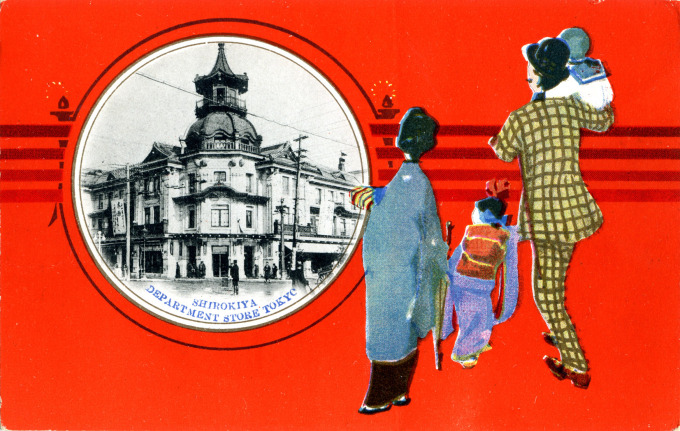
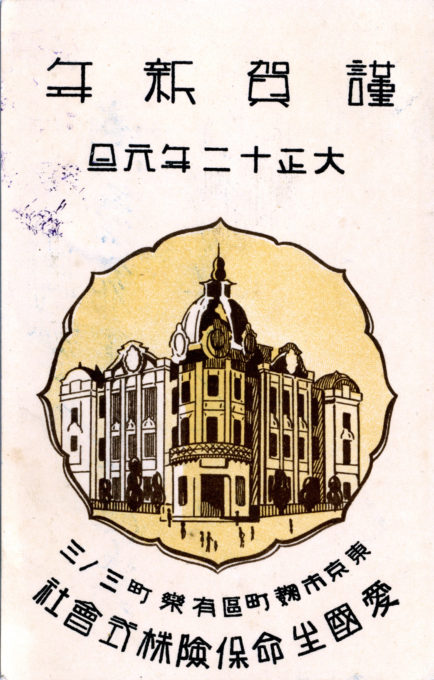
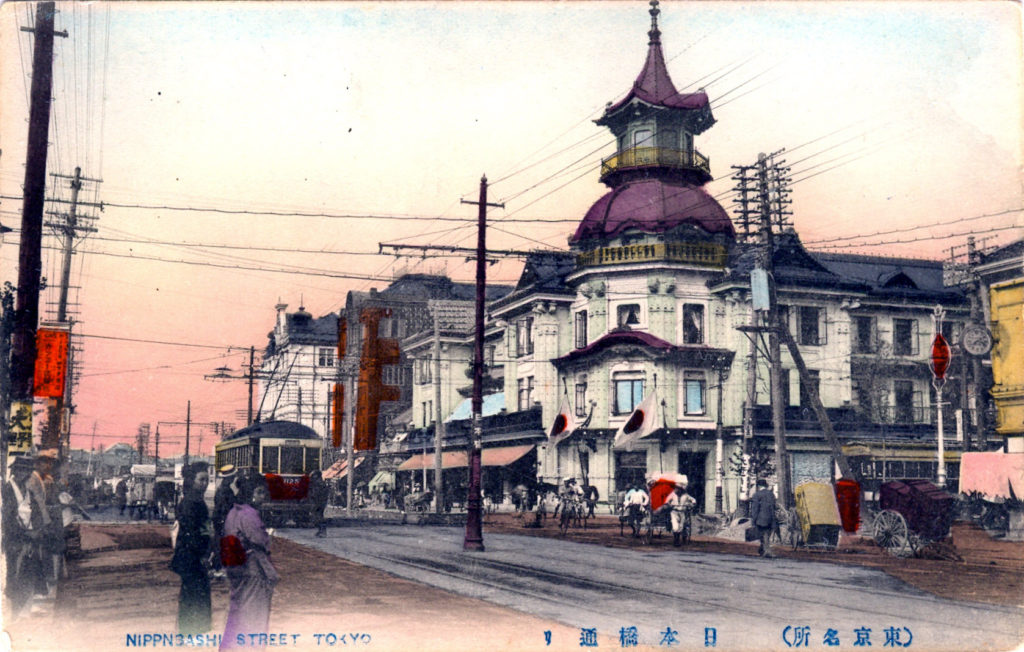
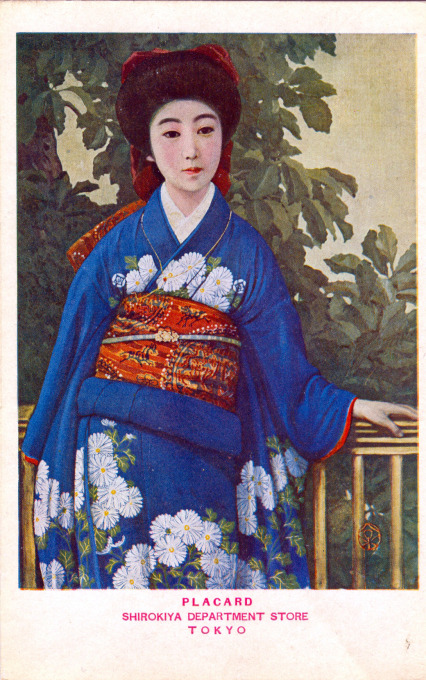
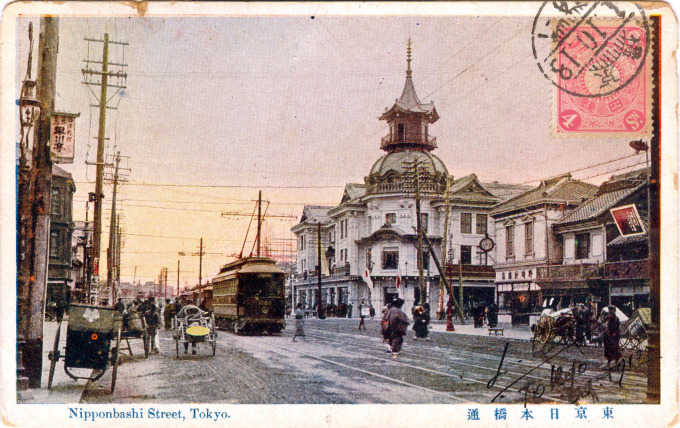
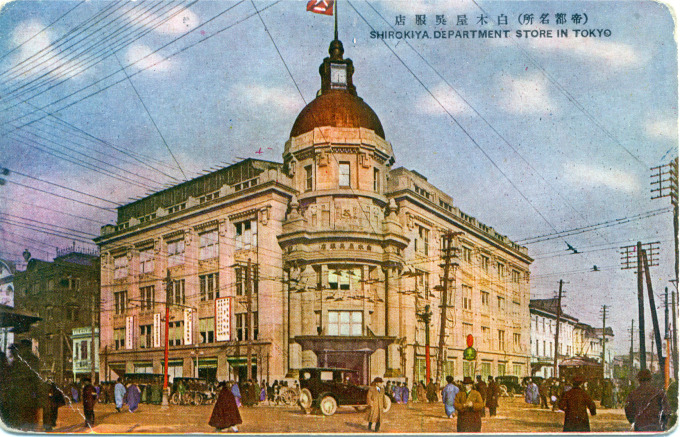

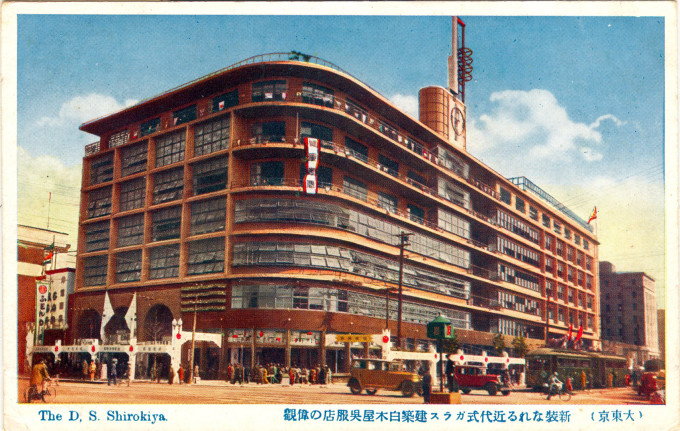
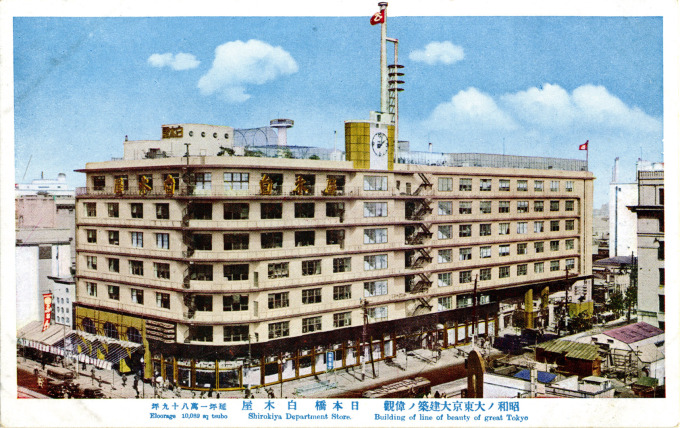
Pingback: Kimono fashion, c. 1910. | Old Tokyo
Pingback: Nihonbashi District | Old Tokyo
Pingback: African Artist and Japanese Designer Create Stunning Kimonos By Mixing Cultures
Pingback: Matsuzakaya Department Store, Ueno (c. 1907-1940). | Old Tokyo
Pingback: Aerial view of Shinagawa Station and nearby hotels, c. 1980. | Old Tokyo
Pingback: Tokyo Department Stores, c. 1930. | Old Tokyo
Pingback: African prints meet Japanese kimonos in beautiful collection created by Cameroonian designer [Photos] | Enlightenment Africa
Pingback: African prints meet Japanese kimonos in beautiful collection created by Cameroonian designer [Photos] - Shaakara.com
Pingback: African prints meet Japanese kimonos in beautiful collection created by Cameroonian designer [Photos] » Akua Publishes
Pingback: 日本の食品サンプルアート – キャロット-99
Pingback: The Japanese Art of Fake Food – Disheshere-99
Pingback: Shirokiya department store advertising postcard, Nihonbashi, Tokyo, c. 1930. | Old TokyoOld Tokyo
Pingback: Xataka – En 1955 Tokyo Tsushin Kogyo creía que su nombre era demasiado complicado para el extranjero. Así que se cambió a Sony – Yacal
Pingback: En 1955 Tokyo Tsushin Kogyo creía que su nombre era demasiado complicado para el extranjero. Así que se cambió a Sony• SALTO CUÁNTICO – Salto Cuántico News
Pingback: En 1955 Tokyo Tsushin Kogyo creía que su nombre era demasiado complicado para el extranjero. Así que se cambió a Sony -
Pingback: En 1955 Tokyo Tsushin Kogyo creía que su nombre era demasiado complicado para el extranjero. Así que se cambió a Sony – Radio Región
Pingback: En 1955 Tokyo Tsushin Kogyo creía que su nombre era demasiado complicado para el extranjero. Así que se cambió a Sony - SistemasGeniales.com - Páginas web, software y redes sociales